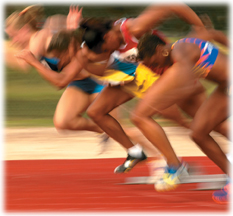Quick Lab
GUIDED INQUIRY
How Does Exercise Affect Disposal of Wastes From Cellular Respiration?

-
Label two test tubes A and B. Put 10 mL of water and a few drops of bromthymol blue solution in each test tube. Carbon dioxide causes bromthymol blue to turn yellow or green.
-
Your partner will time you during this step. When your partner says “go,” slowly blow air through a straw into the bottom of test tube A. CAUTION: Do not inhale through the straw.
-
When the solution changes color, your partner should say “stop” and then record how long the color change took.
-
Jog in place for 2 minutes. CAUTION: Do not do this if you have a medical condition that interferes with exercise. If you feel faint or dizzy, stop immediately and sit down.
-
Repeat steps 2–4 using test tube B.
-
Trade roles with your partner. Repeat steps 1 through 5.
Analyze Data How did exercise affect the time it took the solution to change color?
Infer What process in your body produces carbon dioxide? How does exercise affect this process?
Analyze and Conclude
Energy and Exercise
 How does the body produce ATP during different stages of exercise?
How does the body produce ATP during different stages of exercise?
Bang! The starter's pistol goes off, and the runners push off their starting blocks and sprint down the track, as seen in Figure 9–9. The initial burst of energy soon fades, and the runners settle down to a steady pace. After the runners hit the finish line, they walk around slowly and breathe deeply to catch their breath.
Let's look at what happens at each stage of the race in terms of the pathways the body uses to release energy. Humans have three main sources of ATP: ATP already in muscles, ATP made by lactic acid fermentation, and ATP produced by cellular respiration. At the beginning of a race, the body uses all three ATP sources, but stored ATP and lactic acid fermentation can supply energy only for a limited time.

FIGURE 9–9 Exercise and Energy During a race, runners rely on the energy supplied by ATP to make it to the finish line. Apply Concepts At the beginning of a race, what is the principal source of energy for the runners' muscles?
Quick Energy What happens when your body needs lots of energy in a hurry? In response to sudden danger, quick actions might make the difference between life and death. To an athlete, a sudden burst of speed might win a race.
Cells normally contain small amounts of ATP produced during cellular respiration. When the starting gun goes off in a footrace, the muscles of the runners contain only enough of this ATP for a few seconds of intense activity. Before most of the runners have passed the 50-meter mark, that store of ATP is nearly gone.
Table of Contents
- Formulas and Equations
- Applying Formulas and Equations
- Mean, Median, and Mode
- Estimation
- Using Measurements in Calculations
- Effects of Measurement Errors
- Accuracy
- Precision
- Comparing Accuracy and Precision
- Significant Figures
- Calculating With Significant Figures
- Scientific Notation
- Calculating With Scientific Notation
- Dimensional Analysis
- Applying Dimensional Analysis




